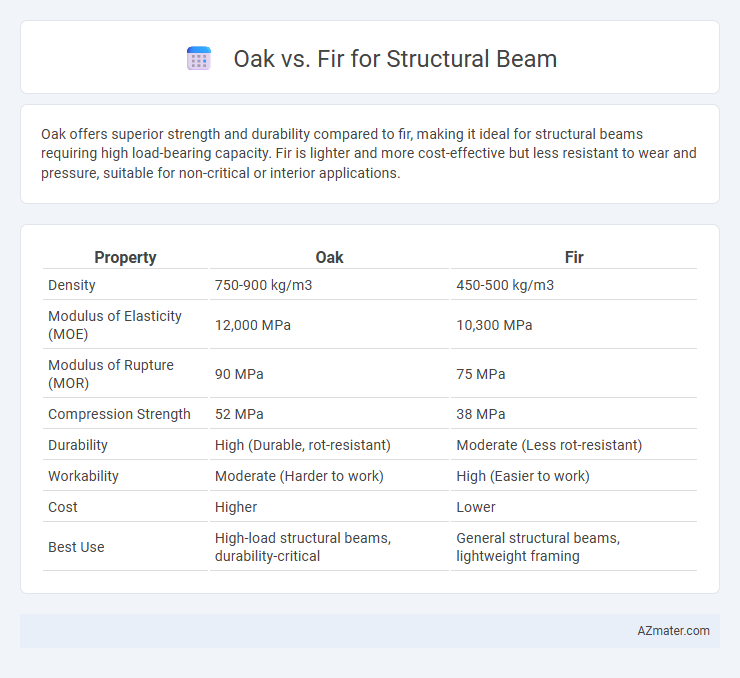Oak offers superior strength and durability compared to fir, making it ideal for structural beams requiring high load-bearing capacity. Fir is lighter and more cost-effective but less resistant to wear and pressure, suitable for non-critical or interior applications.
Table of Comparison
| Property | Oak | Fir |
|---|---|---|
| Density | 750-900 kg/m3 | 450-500 kg/m3 |
| Modulus of Elasticity (MOE) | 12,000 MPa | 10,300 MPa |
| Modulus of Rupture (MOR) | 90 MPa | 75 MPa |
| Compression Strength | 52 MPa | 38 MPa |
| Durability | High (Durable, rot-resistant) | Moderate (Less rot-resistant) |
| Workability | Moderate (Harder to work) | High (Easier to work) |
| Cost | Higher | Lower |
| Best Use | High-load structural beams, durability-critical | General structural beams, lightweight framing |
Introduction to Oak and Fir Structural Beams
Oak structural beams are renowned for their exceptional density, hardness, and durability, making them ideal for heavy-duty construction and long-lasting support. Fir beams, particularly Douglas Fir, offer a favorable strength-to-weight ratio and consistent grain, which provide excellent load-bearing capacity with easier workability. Both woods are commonly used in structural applications, but oak's superior hardness contrasts with fir's lighter weight and ease of installation.
Physical Properties: Oak vs Fir
Oak's high density and hardness provide superior strength and load-bearing capacity compared to fir, making it ideal for structural beams requiring durability. Fir, being lighter with lower density and moderate hardness, offers easier handling and good dimensional stability but less resistance to wear and impact. Oak's superior resistance to bending and compression makes it preferable in applications demanding long-term structural integrity.
Strength and Durability Comparison
Oak beams exhibit superior strength and density, with a Janka hardness rating of approximately 1,290 psi, making them highly resistant to bending and compression under heavy loads. Fir, often Douglas Fir, has a slightly lower hardness rating around 660 psi but offers excellent durability due to its high stiffness and stability, making it a reliable choice for long-span structural beams. Oak's natural resistance to decay and insect attack surpasses that of Fir, though Fir's lighter weight and consistent grain provide ease of handling and reduced warping over time.
Weight and Density Differences
Oak has a higher density ranging from 700 to 900 kg/m3, making it significantly heavier than fir, which typically ranges from 350 to 550 kg/m3. The greater weight of oak provides superior strength and durability for structural beams but requires stronger support and handling equipment. Fir's lighter weight reduces installation challenges and load on foundations, making it a preferred choice where weight constraints are critical.
Resistance to Decay and Insects
Oak exhibits superior resistance to decay and insect damage compared to fir, making it a preferred choice for structural beams in environments prone to moisture and pests. Its dense grain structure contains natural tannins that enhance durability and longevity, reducing the need for chemical treatments. Fir, while lighter and easier to work with, is more susceptible to fungal decay and insect infestation, requiring additional protective measures for long-term structural use.
Workability and Ease of Fabrication
Oak offers excellent workability due to its dense grain and strength, making it ideal for structural beams that require durability and precision. Fir, being softer and lighter than oak, allows easier cutting, nailing, and machining, which reduces fabrication time and effort. While oak demands more specialized tools for shaping and finishing, fir provides greater flexibility for complex designs with less wear on equipment.
Cost Considerations: Oak vs Fir
Oak beams typically cost more than fir due to oak's density and durability, making it a premium choice for structural applications. Fir beams offer a budget-friendly alternative, providing adequate strength for many construction projects at a lower price point. The choice between oak and fir often hinges on balancing upfront costs with long-term performance and maintenance expenses.
Environmental Impact and Sustainability
Oak beams offer superior durability and strength, often sourced from slow-growing forests that may impact carbon sequestration rates but provide long-lasting structural solutions reducing the need for frequent replacements. Fir, especially Douglas fir, is typically harvested from faster-growing plantations with better sustainability certifications, promoting carbon neutrality and forest regeneration. Choosing fir can lower environmental footprints due to its rapid renewability and efficient growth cycles, although oak's longevity compensates by minimizing resource consumption over the building lifespan.
Aesthetic Qualities for Exposed Beams
Oak offers a rich, warm grain with a pronounced texture, making it a popular choice for exposed beams that demand a rustic yet elegant look. Fir features a lighter color with a straighter, more uniform grain pattern, providing a clean and modern aesthetic for structural beams. Both woods age gracefully, but oak develops a deeper patina over time, enhancing its visual character, while fir retains its bright and smooth appearance.
Best Applications: Choosing Oak or Fir
Oak offers exceptional strength and durability, making it ideal for heavy-load-bearing structural beams in residential and commercial construction. Fir provides a lighter weight option with good flexibility, suited for framing and long-span beams where reducing overall weight is crucial. Selecting oak or fir depends on specific project requirements such as load capacity, aesthetic preferences, and budget constraints.

Infographic: Oak vs Fir for Structural Beam
 azmater.com
azmater.com